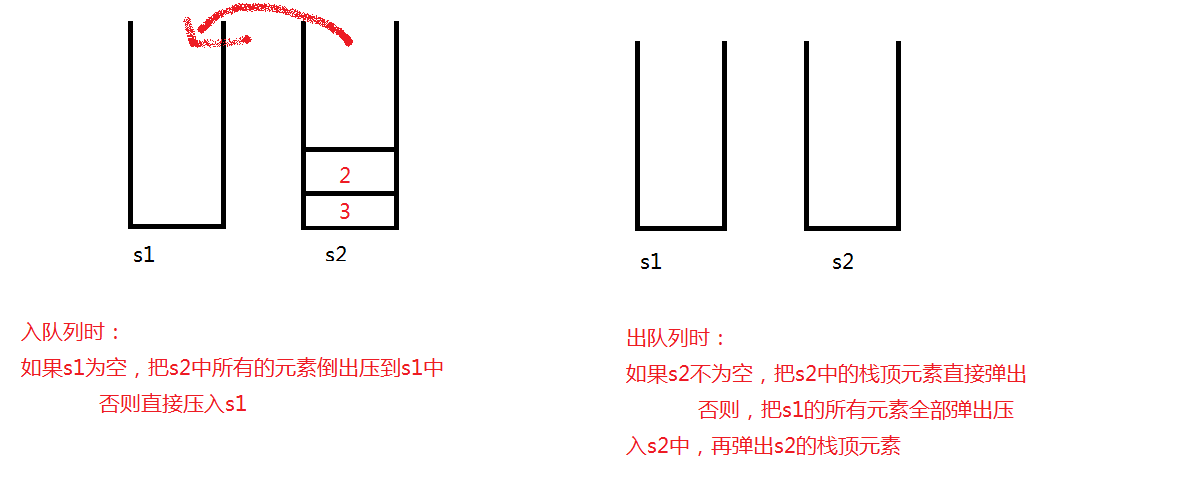http://blog.csdn.net/hanjing_1995/article/details/51539578
使用两个栈实现一个队列
思路一:
我们设定s1是入栈的,s2是出栈的。
入队列,直接压到s1即可
出队列,先把s1中的元素倒入到s2中,弹出s2中的栈顶元素;再把s2的剩余元素全部倒回s1中。
![N)TC$P%C[LL3~L]Z)$XO15R.png wKioL1cMpjajUzcyAABT0frZ3KM694.png](http://s5.51cto.com/wyfs02/M01/7E/E7/wKioL1cMpjajUzcyAABT0frZ3KM694.png)
缺点:
每次只要出栈一个元素就要将元素倒来倒去,麻烦!!!
思路2:
入队列时:
如果s1为空,把s2中所有的元素倒出压到s1中。否则直接压入s1
出队列时:
如果s2不为空,把s2中的栈顶元素直接弹出。否则,把s1的所有元素全部弹出压入s2中,再弹出s2的栈顶元素

思路1无条件地每次都要将元素倒来倒去,思路2出队时较思路1简单
思路3:
我们设定s1是入栈的,s2是出栈的
入队列:直接压入元素至s1即可
出队列:如果s2不为空,把s2中的栈顶元素直接弹出。否则,把s1的所有元素全部弹出压入s2中,再弹出s2的栈顶元素
![N)TC$P%C[LL3~L]Z)$XO15R.png wKioL1cMp8HR1m6aAABLlSxXUHE848.png](http://s5.51cto.com/wyfs02/M02/7E/E7/wKioL1cMp8HR1m6aAABLlSxXUHE848.png)
相比于方法2,入队直接压入即可~
那么,我们可以看出,思路三最简单,我们下面看下代码。
代码实现:
1)我们直接调用库里的stack来实现。(一般调用库里的就行了)
[cpp] view plain copy
- #define _CRT_SECURE_NO_WARNINGS 1
- #include<iostream>
- using namespace std;
- //两个栈实现一个队列
- #include<stack>
- template<class T>
- class Queue
- {
- public:
- void appendTail(const T& x)
- {
- s1.push(x);
- }
- void deleteHead()
- {
- if (s2.empty())
- {
- while (!s1.empty())
- {
- s2.push(s1.top());
- s1.pop();
- }
- cout << s2.top() << " ";
- s2.pop();
- }
- else
- {
- cout << s2.top() << " ";
- s2.pop();
- }
- }
- private:
- stack<T> s1;
- stack<T> s2;
- };
- void Test()
- {
- Queue<int> q;
- q.appendTail(1);
- q.appendTail(2);
- q.appendTail(3);
- q.appendTail(4);
- q.deleteHead();
- q.deleteHead();
- q.deleteHead();
- q.deleteHead();
- }
- int main()
- {
- Test();
- system("pause");
- return 0;
- }
2)自己实现栈实现。
[cpp] view plain copy
- #define _CRT_SECURE_NO_WARNINGS 1
- #include<iostream>
- using namespace std;
- #include<assert.h>
- //直接实现Stack,也可以用适配器实现栈,或者用库。
- //将Stack基本功能实现如下:
- template<class T>
- class Stack
- {
- public:
- Stack()
- :_array(NULL)
- , _size(0)
- , _capacity(0)
- {}
- Stack<T>(const Stack<T>& s)
- : _array(new T[s._capacity])
- {
- swap(_array, s._array);
- swap(_size, s._size);
- swap(_capacity, s._capacity);
- }
- Stack<T>& operator=(const Stack<T>& s)
- {
- if (&s != this)
- {
- swap(_array, s._array);
- swap(_size, s._size);
- swap(_capacity, s._capacity);
- }
- return *this;
- }
- ~Stack()
- {
- if (_array)
- {
- delete[] _array;
- _array = NULL;
- }
- }
- void _CheckCapacity()
- {
- if (_size == 0)
- {
- _capacity = 3;
- _array = new T[_capacity];
- }
- if (_size >= _capacity)
- {
- _capacity *= 2;
- T* tmp = new T[_capacity];
- for (int index = 0; index < _size; index++)
- {
- tmp[index] = _array[index];
- }
- delete[] _array;
- _array = tmp;
- }
- }
- void Push(const T& x)
- {
- _CheckCapacity();
- _array[_size++] = x;
- }
- void Pop()
- {
- if (_size == 0)
- {
- return;
- }
- --_size;
- }
- size_t Size()
- {
- return _size;
- }
- bool Empty()
- {
- return Size() == 0;
- }
- T& Top()
- {
- assert(_size > 0);
- return _array[_size - 1];
- }
- private:
- T* _array;
- size_t _size;
- size_t _capacity;
- };
- template<class T>
- class Queue
- {
- public:
- void InQueue(const T& x)
- {
- s1.Push(x);
- }
- void OutQueue()
- {
- //栈s2为空,则将栈s1的元素全部倒入s2中,再弹出最上面的那个元素
- if (s2.Empty())
- {
- while (!s1.Empty())
- {
- s2.Push(s1.Top());
- s1.Pop();
- }
- s2.Pop();
- }
- //栈s2不为空,直接弹出元素
- else
- {
- s2.Pop();
- }
- }
- void Print() //打印队列元素,分四种情况。
- {
- if (s1.Empty() && s2.Empty())
- {
- cout << "The Queue is Empty!";
- }
- else if (!s1.Empty() && s2.Empty())
- {
- while (!s1.Empty())
- {
- s2.Push(s1.Top());
- s1.Pop();
- }
- while (!s2.Empty())
- {
- cout << s2.Top() << " ";
- s2.Pop();
- }
- }
- else if (s1.Empty() && !s2.Empty())
- {
- while (!s2.Empty())
- {
- cout << s2.Top() << " ";
- s2.Pop();
- }
- }
- else
- {
- while (!s2.Empty())
- {
- cout << s2.Top() << " ";
- s2.Pop();
- }
- while (!s1.Empty())
- {
- s2.Push(s1.Top());
- s1.Pop();
- }
- while (!s2.Empty())
- {
- cout << s2.Top() << " ";
- s2.Pop();
- }
- }
- cout << endl;
- }
- private:
- Stack<T> s1; //入队
- Stack<T> s2; //出队
- };
- //测试两个栈实现一个队列
- void Test1()
- {
- Queue<int> q1;
- q1.InQueue(1);
- q1.InQueue(2);
- q1.InQueue(3);
- q1.InQueue(4);
- /*q1.Print();*/
- q1.OutQueue();
- /*q1.Print();*/
- q1.InQueue(5);
- q1.InQueue(6);
- q1.InQueue(7);
- q1.Print();
- }
- int main()
- {
- Test1();
- system("pause");
- return 0;
- }
(1个细节):
注意再将元素倒入另一个栈时,代码并不是先pop,再push。因为这样push后元素就找不到了。因此要先访问到栈顶元素top,再push,而后pop。
本文出自 “Han Jing's Blog” 博客,请务必保留此出处http://10740184.blog.51cto.com/10730184/1763006



















